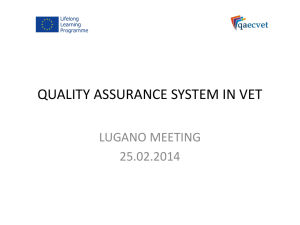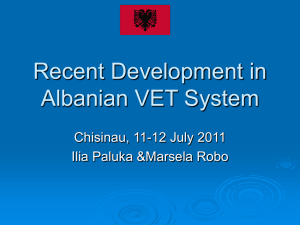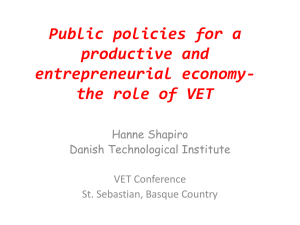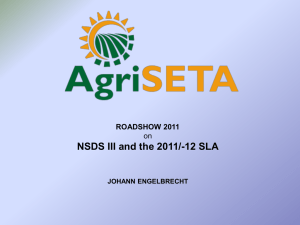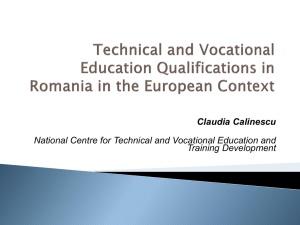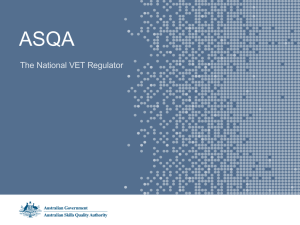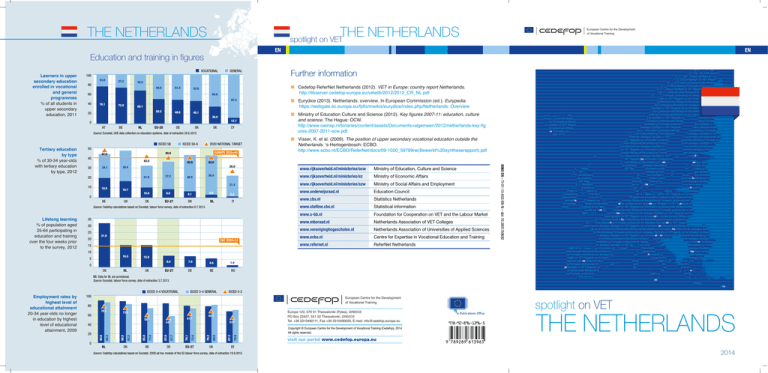
THE NETHERLANDS
THE NETHERLANDS
spotlight on VET
EN
Education and training in figures
Learners in upper
secondary education
enrolled in vocational
and general
programmes
% of all students in
upper secondary
education, 2011
VOCATIONAL
GENERAL
100
23.9
80
27.2
30.9
49.5
51.4
64.0
87.3
76.1
72.8
69.1
50.5
20
48.6
46.1
36.0
12.7
0
AT
NL
BE
EU-28
DE
DK
UK
CY
Source: Eurostat, UOE data collection on education systems, date of extraction 28.6.2013.
ISCED 5A-6
2020 NATIONAL TARGET
50
30
42.0
24.1
40.0
26.0
21.9
27.2
36.9
39.4
21.4
19.8
16.7
0
BE
UK
10.0
8.6
6.1
2.9
0.3
DE
EU-27
DK
NL
IT
Source: Cedefop calculations based on Eurostat, labour force survey, date of extraction 8.7.2013.
Lifelong learning
% of population aged
25-64 participating in
education and training
over the four weeks prior
to the survey, 2012
35
30
25
20
■ Eurydice (2013). Netherlands: overview. In European Commission (ed.). Eurypedia.
https://webgate.ec.europa.eu/fpfis/mwikis/eurydice/index.php/Netherlands: Overview
■ Ministry of Education Culture and Science (2012). Key figures 2007-11: education, culture
and science. The Hague: OCW.
http://www.owinsp.nl/binaries/content/assets/Documents+algemeen/2012/netherlands-key-fig
ures-2007-2011-ocw.pdf
■ Visser, K. et al. (2009). The position of upper secondary vocational education outside the
Netherlands. ‘s-Hertogenbosch: ECBO.
http://www.ecbo.nl/ECBO/ReferNet/docs/09-1020_59799ne(Bewerkt%20syntheserapport).pdf
40.0
30.4
20
10
EUROPE 2020=40
40.0
47.0
40
Further information
31.6
E&T 2020=15
15
www.rijksoverheid.nl/ministeries/ocw
Ministry of Education, Culture and Science
www.rijksoverheid.nl/ministeries/ez
Ministry of Economic Affairs
www.rijksoverheid.nl/ministeries/szw
Ministry of Social Affairs and Employment
www.onderwijsraad.nl
Education Council
www.cbs.nl
Statistics Netherlands
www.statline.cbs.nl
Statistical information
www.s-bb.nl
Foundation for Cooperation on VET and the Labour Market
www.mboraad.nl
Netherlands Association of VET Colleges
www.vereniginghogescholen.nl
Netherlands Association of Universities of Applied Sciences
www.ecbo.nl
Centre for Expertise in Vocational Education and Training
www.refernet.nl
ReferNet Netherlands
8065 EN – TI-01-13-653-EN-N – doi: 10.2801/50692
Tertiary education
by type
% of 30-34 year-olds
with tertiary education
by type, 2012
ISCED 5B
EN
■ Cedefop ReferNet Netherlands (2012). VET in Europe: country report Netherlands.
http://libserver.cedefop.europa.eu/vetelib/2012/2012_CR_NL.pdf
53.9
60
40
European Centre for the Development
of Vocational Training
10
16.5
5
15.8
0
DK
NL
UK
9.0
7.9
6.6
1.4
EU-27
DE
BE
RO
NB: Data for NL are provisional.
Source: Eurostat, labour force survey, date of extraction 3.7.2013.
ISCED 3-4 VOCATIONAL
ISCED 3-4 GENERAL
ISCED 0-2
100
European Centre for the Development
of Vocational Training
80
76.9
60
73.9
58.1
40
0
NL
DK
BE
65.8
53.6
DE
EU-27
UK
70.8
67.3
80.6
78.2
73.5
79.1
57.7
83.9
73.8
85.0
82.5
88.5
85.9
20
61.7
54.2
Europe 123, 570 01 Thessaloniki (Pylea), GREECE
PO Box 22427, 551 02 Thessaloniki, GREECE
Tel. +30 2310490111, Fax +30 2310490020, E-mail: info@cedefop.europa.eu
Copyright © European Centre for the Development of Vocational Training (Cedefop), 2014
All rights reserved.
90.6
Employment rates by
highest level of
educational attainment
20-34 year-olds no longer
in education by highest
level of educational
attainment, 2009
spotlight on VET
978-92-896-1396-5
THE NETHERLANDS
visit our portal www.cedefop.europa.eu
EE
Source: Cedefop calculations based on Eurostat, 2009 ad hoc module of the EU labour force survey, date of extraction 19.9.2012.
2014
THE NETHERLANDS
spotlight on VET
VET in the Netherlands
Learners leaving primary education at age 12 go
on to various schools in the secondary education
category. From the third year at lower secondary
level (14 year-olds) onwards, about a quarter of
students follow programmes that can be
characterised as pre-vocational (part of preparatory
secondary vocational education (VMBO)).
For learners not capable of entering
pre-vocational education, separate labour-oriented
practical training is offered (praktijkonderwijs).
There are two types of programmes at upper
secondary level that provide general education:
upper secondary general education (HAVO) and
pre-university education (VWO).
Upper secondary vocational education (MBO) is
also available. Three structural elements determine
this type of education: differentiation according to
level, programme orientation and learning pathway:
• level: upper secondary vocational education has
four levels corresponding to EQF levels 1 to 4.
At which level students start depends on what
prior education they have and the diploma
obtained. There are no minimum admission
requirements for levels 1 and 2 in this type of
education; however, this will change in the near
future. From summer 2014 onwards, only the
level 1 programmes will be without a threshold.
It is possible to move (upwards) within upper
secondary vocational education and the highest
level 4 (EQF 4) gives access to associate
degree or bachelor programmes in higher
professional education (HBO) offered by
universities of applied sciences;
• programme: vocational training programmes are
offered in four sectors; green/agriculture,
technology, economics and care and welfare.
There are a total of 237 dossiers that describe
interrelated qualifications; there are 612 different
diplomas;
• learning pathway: upper secondary vocational
education has a school-based pathway (BOL)
and a dual pathway (BBL). In the school-based
pathway, students spend at least 20% of their
time on work placement. In the dual pathway,
VET in the Dutch education and training system
students have jobs that they combine with a
course of study (apprenticeship); this often
involves four days’ work a week and one day at
school.
Higher professional education (HBO) is open to
students with upper secondary general education
diplomas. Transferring to this type of higher
education is also possible with a diploma at level 4
of upper secondary vocational education: 50% of
students with a qualification at MBO-4 level enter
the job market while the other half go on to higher
professional education. The majority of these
students pursue a four-year professional bachelor
degree programme. Moreover, in recent years
two-year associate degree programmes have been
developed (short-cycle higher education) and
students with a bachelor degree can transfer to a
professional master degree programme, albeit still
to a limited extent.
There is no institutional framework for continuing
vocational education and training (CVET).
Provision is market-driven with many suppliers.
Social partners can stimulate CVET with help from
their branch-specific training and development
funds. Publicly-financed part-time/dual initial VET
can also function as CVET for adults.
In upper secondary vocational education the
national qualification structure defines
qualifications’ desired outcome. Social partners and
education, represented in sectoral institutions, have
the legal task to develop and maintain these
qualifications. Once determined by the Ministry of
Education, Culture and Science/Economic Affairs,
schools develop – in cooperation with training firms
– curricula based on the qualification profiles.
TERTIARY LEVEL
Distinctive features of VET
ADULT LEARNING/CONTINUING TRAINING
Specialised
programmes
for employees
(often financed by
training funds)
EQF 8
PhD programmes,
3 years
ISCED 6
Specialised
programmes
for unemployed
EQF 7
Master programmes,
3 years
ISCED 5A
EQF 7
Bridging
programme
Prof. master programme, 1 year
POST-SECONDARY LEVEL
EQF 6
EQF 6
Bachelor
programmes,
3 years
ISCED 5A
18+
14+
20
16
19
15
18
17
15
11
14
10
13
9
AGE
Specialising programmes,
1-2 years
ISCED 4C
EQF 3
EQF 4
EQF 4
13
12
EQF 4
EQF 4
14
16
Higher professional bachelor
programmes,
EQF 5
2-4 years
Associate degree,
2 years ISCED 5B
ISCED 5A
Pre-university
education
(integrated
lower and
upper
secondary
programmes),
6 years
Integrated
lower and
upper
secondary
programmes,
5 years
Middlemanagement
VET programmes (*),
4 years
Professional
education programmes (*),
3 years
ISCED 3A
ISCED 3C
EQF 2
EQF 2
Basic
vocational programmes (*),
2 years
EQF 1
Assistant
training (*),
1-1.5 years
ISCED 3C
EQF 1
ISCED 2C
Practical,
labouroriented
programmes
for students
with
learning
difficulties
Lower secondary school-based pre-vocational
programmes
ISCED 2A/3A
ISCED 2A/3A
ISCED 2B
ISCED 2C
ISCED 2B
SECONDARY LEVEL
YEARS in E&T
General education programmes
Giving access to tertiary education
VET programmes
Possible progression route
Programmes combining VET and general education
End of compulsory education (with primary education certificate;
if unsuccessful, learners must continue to age 18)
Also available to adults (full- or part-time or distance education)
Prior VET knowledge may be recognised, affecting the duration of the programme
Officially recognised vocational qualifications
Qualifications allowing access to the next educational level
NB: ISCED 1997 was used on the chart. Conversion to ISCED 2011 is ongoing.
Source: Cedefop and ReferNet Netherlands.
No entry requirements for learners over 16
(*)
All upper secondary level VET programmes can either be mainly school-based
(part of it in enterprises) or apprenticeships
Compared to other countries, upper secondary VET
in the Netherlands has the following special
characteristics:
• vocational education and training (VET) is the
joint responsibility of government, social partners
and educational institutions. The business
community plays a relevant part in developing
qualifications and providing apprenticeships;
• publicly-funded providers of VET programmes
are multisectoral, large regional institutions
(averaging 12 000 students at each regional
training centre (ROC) and several specialist
schools, including agricultural training centres).
ROCs provide vocational education for young
people and adults (IVET), in addition to general
adult education; they are active on the continuing
VET market with privately-funded programmes.
Government-regulated IVET programmes are
also provided by privately-funded institutions.
The heterogeneous and multifunctional nature of
upper secondary VET is unique compared to
other countries;
• the two learning pathways in upper secondary
VET lead to the same diplomas. They operate
like a system of communicating vessels so that
the learning pathways' volume of intake can
move with the economic trend: increase of
students in the school-based pathway during a
period of economic recession and decrease in
the dual pathway; and the opposite during a
period of boom;
• educational institutions are given a high degree
of freedom to design vocational education as
they see fit. The VET law provides a broad
framework only outlining some key elements at
system level; institutions receive a lump sum for
their tasks.
Challenges
Three, to some extent conflicting, principles are
crucial for the VET system: accessibility, quality
and efficiency. Striking a good balance so that
each principle is applied optimally is a constant
challenge.
In practical terms, this means, first, that
Dutch upper secondary VET works towards
developing talents of its highly heterogeneous
student population – from students who transfer
to higher education right down to students for
whom obtaining a minimal basic qualification is
too difficult. VET has to be accessible and
attainable for all target groups.
At the same time, the challenge is to raise
quality and effectiveness of upper secondary
VET. Key aspects of this objective are: further
reduction in numbers of early school-leavers
and more students attaining their diplomas at
various vocational education levels. Recently,
basic skills requirements (language, elementary
mathematics) were tightened to improve quality;
central testing of these basic skills is currently
being implemented in various forms of
education, including upper secondary vocational
education. The challenge – related to VET
programmes’ design – is to find a good balance
between generic key skills with a high transfer
value and specific knowledge and skills from
different vocations.
A third challenge lies in increasing efficiency
of upper secondary vocational education, where
the following developments play a role: moving
towards an all-embracing system of
qualifications for secondary vocations and
corresponding training courses; reducing
numbers of qualifications while ensuring they
are widely on offer throughout the Netherlands;
and decreasing duration of training, in particular
longer courses in upper secondary VET.
While emphasis in the first decade of this
century was on guaranteeing accessibility of the
VET system, principles of efficiency and quality
have, for the past four years, been receiving
more attention.
THE NETHERLANDS
spotlight on VET
VET in the Netherlands
Learners leaving primary education at age 12 go
on to various schools in the secondary education
category. From the third year at lower secondary
level (14 year-olds) onwards, about a quarter of
students follow programmes that can be
characterised as pre-vocational (part of preparatory
secondary vocational education (VMBO)).
For learners not capable of entering
pre-vocational education, separate labour-oriented
practical training is offered (praktijkonderwijs).
There are two types of programmes at upper
secondary level that provide general education:
upper secondary general education (HAVO) and
pre-university education (VWO).
Upper secondary vocational education (MBO) is
also available. Three structural elements determine
this type of education: differentiation according to
level, programme orientation and learning pathway:
• level: upper secondary vocational education has
four levels corresponding to EQF levels 1 to 4.
At which level students start depends on what
prior education they have and the diploma
obtained. There are no minimum admission
requirements for levels 1 and 2 in this type of
education; however, this will change in the near
future. From summer 2014 onwards, only the
level 1 programmes will be without a threshold.
It is possible to move (upwards) within upper
secondary vocational education and the highest
level 4 (EQF 4) gives access to associate
degree or bachelor programmes in higher
professional education (HBO) offered by
universities of applied sciences;
• programme: vocational training programmes are
offered in four sectors; green/agriculture,
technology, economics and care and welfare.
There are a total of 237 dossiers that describe
interrelated qualifications; there are 612 different
diplomas;
• learning pathway: upper secondary vocational
education has a school-based pathway (BOL)
and a dual pathway (BBL). In the school-based
pathway, students spend at least 20% of their
time on work placement. In the dual pathway,
VET in the Dutch education and training system
students have jobs that they combine with a
course of study (apprenticeship); this often
involves four days’ work a week and one day at
school.
Higher professional education (HBO) is open to
students with upper secondary general education
diplomas. Transferring to this type of higher
education is also possible with a diploma at level 4
of upper secondary vocational education: 50% of
students with a qualification at MBO-4 level enter
the job market while the other half go on to higher
professional education. The majority of these
students pursue a four-year professional bachelor
degree programme. Moreover, in recent years
two-year associate degree programmes have been
developed (short-cycle higher education) and
students with a bachelor degree can transfer to a
professional master degree programme, albeit still
to a limited extent.
There is no institutional framework for continuing
vocational education and training (CVET).
Provision is market-driven with many suppliers.
Social partners can stimulate CVET with help from
their branch-specific training and development
funds. Publicly-financed part-time/dual initial VET
can also function as CVET for adults.
In upper secondary vocational education the
national qualification structure defines
qualifications’ desired outcome. Social partners and
education, represented in sectoral institutions, have
the legal task to develop and maintain these
qualifications. Once determined by the Ministry of
Education, Culture and Science/Economic Affairs,
schools develop – in cooperation with training firms
– curricula based on the qualification profiles.
TERTIARY LEVEL
Distinctive features of VET
ADULT LEARNING/CONTINUING TRAINING
Specialised
programmes
for employees
(often financed by
training funds)
EQF 8
PhD programmes,
3 years
ISCED 6
Specialised
programmes
for unemployed
EQF 7
Master programmes,
3 years
ISCED 5A
EQF 7
Bridging
programme
Prof. master programme, 1 year
POST-SECONDARY LEVEL
EQF 6
EQF 6
Bachelor
programmes,
3 years
ISCED 5A
18+
14+
20
16
19
15
18
17
15
11
14
10
13
9
AGE
Specialising programmes,
1-2 years
ISCED 4C
EQF 3
EQF 4
EQF 4
13
12
EQF 4
EQF 4
14
16
Higher professional bachelor
programmes,
EQF 5
2-4 years
Associate degree,
2 years ISCED 5B
ISCED 5A
Pre-university
education
(integrated
lower and
upper
secondary
programmes),
6 years
Integrated
lower and
upper
secondary
programmes,
5 years
Middlemanagement
VET programmes (*),
4 years
Professional
education programmes (*),
3 years
ISCED 3A
ISCED 3C
EQF 2
EQF 2
Basic
vocational programmes (*),
2 years
EQF 1
Assistant
training (*),
1-1.5 years
ISCED 3C
EQF 1
ISCED 2C
Practical,
labouroriented
programmes
for students
with
learning
difficulties
Lower secondary school-based pre-vocational
programmes
ISCED 2A/3A
ISCED 2A/3A
ISCED 2B
ISCED 2C
ISCED 2B
SECONDARY LEVEL
YEARS in E&T
General education programmes
Giving access to tertiary education
VET programmes
Possible progression route
Programmes combining VET and general education
End of compulsory education (with primary education certificate;
if unsuccessful, learners must continue to age 18)
Also available to adults (full- or part-time or distance education)
Prior VET knowledge may be recognised, affecting the duration of the programme
Officially recognised vocational qualifications
Qualifications allowing access to the next educational level
NB: ISCED 1997 was used on the chart. Conversion to ISCED 2011 is ongoing.
Source: Cedefop and ReferNet Netherlands.
No entry requirements for learners over 16
(*)
All upper secondary level VET programmes can either be mainly school-based
(part of it in enterprises) or apprenticeships
Compared to other countries, upper secondary VET
in the Netherlands has the following special
characteristics:
• vocational education and training (VET) is the
joint responsibility of government, social partners
and educational institutions. The business
community plays a relevant part in developing
qualifications and providing apprenticeships;
• publicly-funded providers of VET programmes
are multisectoral, large regional institutions
(averaging 12 000 students at each regional
training centre (ROC) and several specialist
schools, including agricultural training centres).
ROCs provide vocational education for young
people and adults (IVET), in addition to general
adult education; they are active on the continuing
VET market with privately-funded programmes.
Government-regulated IVET programmes are
also provided by privately-funded institutions.
The heterogeneous and multifunctional nature of
upper secondary VET is unique compared to
other countries;
• the two learning pathways in upper secondary
VET lead to the same diplomas. They operate
like a system of communicating vessels so that
the learning pathways' volume of intake can
move with the economic trend: increase of
students in the school-based pathway during a
period of economic recession and decrease in
the dual pathway; and the opposite during a
period of boom;
• educational institutions are given a high degree
of freedom to design vocational education as
they see fit. The VET law provides a broad
framework only outlining some key elements at
system level; institutions receive a lump sum for
their tasks.
Challenges
Three, to some extent conflicting, principles are
crucial for the VET system: accessibility, quality
and efficiency. Striking a good balance so that
each principle is applied optimally is a constant
challenge.
In practical terms, this means, first, that
Dutch upper secondary VET works towards
developing talents of its highly heterogeneous
student population – from students who transfer
to higher education right down to students for
whom obtaining a minimal basic qualification is
too difficult. VET has to be accessible and
attainable for all target groups.
At the same time, the challenge is to raise
quality and effectiveness of upper secondary
VET. Key aspects of this objective are: further
reduction in numbers of early school-leavers
and more students attaining their diplomas at
various vocational education levels. Recently,
basic skills requirements (language, elementary
mathematics) were tightened to improve quality;
central testing of these basic skills is currently
being implemented in various forms of
education, including upper secondary vocational
education. The challenge – related to VET
programmes’ design – is to find a good balance
between generic key skills with a high transfer
value and specific knowledge and skills from
different vocations.
A third challenge lies in increasing efficiency
of upper secondary vocational education, where
the following developments play a role: moving
towards an all-embracing system of
qualifications for secondary vocations and
corresponding training courses; reducing
numbers of qualifications while ensuring they
are widely on offer throughout the Netherlands;
and decreasing duration of training, in particular
longer courses in upper secondary VET.
While emphasis in the first decade of this
century was on guaranteeing accessibility of the
VET system, principles of efficiency and quality
have, for the past four years, been receiving
more attention.
THE NETHERLANDS
spotlight on VET
VET in the Netherlands
Learners leaving primary education at age 12 go
on to various schools in the secondary education
category. From the third year at lower secondary
level (14 year-olds) onwards, about a quarter of
students follow programmes that can be
characterised as pre-vocational (part of preparatory
secondary vocational education (VMBO)).
For learners not capable of entering
pre-vocational education, separate labour-oriented
practical training is offered (praktijkonderwijs).
There are two types of programmes at upper
secondary level that provide general education:
upper secondary general education (HAVO) and
pre-university education (VWO).
Upper secondary vocational education (MBO) is
also available. Three structural elements determine
this type of education: differentiation according to
level, programme orientation and learning pathway:
• level: upper secondary vocational education has
four levels corresponding to EQF levels 1 to 4.
At which level students start depends on what
prior education they have and the diploma
obtained. There are no minimum admission
requirements for levels 1 and 2 in this type of
education; however, this will change in the near
future. From summer 2014 onwards, only the
level 1 programmes will be without a threshold.
It is possible to move (upwards) within upper
secondary vocational education and the highest
level 4 (EQF 4) gives access to associate
degree or bachelor programmes in higher
professional education (HBO) offered by
universities of applied sciences;
• programme: vocational training programmes are
offered in four sectors; green/agriculture,
technology, economics and care and welfare.
There are a total of 237 dossiers that describe
interrelated qualifications; there are 612 different
diplomas;
• learning pathway: upper secondary vocational
education has a school-based pathway (BOL)
and a dual pathway (BBL). In the school-based
pathway, students spend at least 20% of their
time on work placement. In the dual pathway,
VET in the Dutch education and training system
students have jobs that they combine with a
course of study (apprenticeship); this often
involves four days’ work a week and one day at
school.
Higher professional education (HBO) is open to
students with upper secondary general education
diplomas. Transferring to this type of higher
education is also possible with a diploma at level 4
of upper secondary vocational education: 50% of
students with a qualification at MBO-4 level enter
the job market while the other half go on to higher
professional education. The majority of these
students pursue a four-year professional bachelor
degree programme. Moreover, in recent years
two-year associate degree programmes have been
developed (short-cycle higher education) and
students with a bachelor degree can transfer to a
professional master degree programme, albeit still
to a limited extent.
There is no institutional framework for continuing
vocational education and training (CVET).
Provision is market-driven with many suppliers.
Social partners can stimulate CVET with help from
their branch-specific training and development
funds. Publicly-financed part-time/dual initial VET
can also function as CVET for adults.
In upper secondary vocational education the
national qualification structure defines
qualifications’ desired outcome. Social partners and
education, represented in sectoral institutions, have
the legal task to develop and maintain these
qualifications. Once determined by the Ministry of
Education, Culture and Science/Economic Affairs,
schools develop – in cooperation with training firms
– curricula based on the qualification profiles.
TERTIARY LEVEL
Distinctive features of VET
ADULT LEARNING/CONTINUING TRAINING
Specialised
programmes
for employees
(often financed by
training funds)
EQF 8
PhD programmes,
3 years
ISCED 6
Specialised
programmes
for unemployed
EQF 7
Master programmes,
3 years
ISCED 5A
EQF 7
Bridging
programme
Prof. master programme, 1 year
POST-SECONDARY LEVEL
EQF 6
EQF 6
Bachelor
programmes,
3 years
ISCED 5A
18+
14+
20
16
19
15
18
17
15
11
14
10
13
9
AGE
Specialising programmes,
1-2 years
ISCED 4C
EQF 3
EQF 4
EQF 4
13
12
EQF 4
EQF 4
14
16
Higher professional bachelor
programmes,
EQF 5
2-4 years
Associate degree,
2 years ISCED 5B
ISCED 5A
Pre-university
education
(integrated
lower and
upper
secondary
programmes),
6 years
Integrated
lower and
upper
secondary
programmes,
5 years
Middlemanagement
VET programmes (*),
4 years
Professional
education programmes (*),
3 years
ISCED 3A
ISCED 3C
EQF 2
EQF 2
Basic
vocational programmes (*),
2 years
EQF 1
Assistant
training (*),
1-1.5 years
ISCED 3C
EQF 1
ISCED 2C
Practical,
labouroriented
programmes
for students
with
learning
difficulties
Lower secondary school-based pre-vocational
programmes
ISCED 2A/3A
ISCED 2A/3A
ISCED 2B
ISCED 2C
ISCED 2B
SECONDARY LEVEL
YEARS in E&T
General education programmes
Giving access to tertiary education
VET programmes
Possible progression route
Programmes combining VET and general education
End of compulsory education (with primary education certificate;
if unsuccessful, learners must continue to age 18)
Also available to adults (full- or part-time or distance education)
Prior VET knowledge may be recognised, affecting the duration of the programme
Officially recognised vocational qualifications
Qualifications allowing access to the next educational level
NB: ISCED 1997 was used on the chart. Conversion to ISCED 2011 is ongoing.
Source: Cedefop and ReferNet Netherlands.
No entry requirements for learners over 16
(*)
All upper secondary level VET programmes can either be mainly school-based
(part of it in enterprises) or apprenticeships
Compared to other countries, upper secondary VET
in the Netherlands has the following special
characteristics:
• vocational education and training (VET) is the
joint responsibility of government, social partners
and educational institutions. The business
community plays a relevant part in developing
qualifications and providing apprenticeships;
• publicly-funded providers of VET programmes
are multisectoral, large regional institutions
(averaging 12 000 students at each regional
training centre (ROC) and several specialist
schools, including agricultural training centres).
ROCs provide vocational education for young
people and adults (IVET), in addition to general
adult education; they are active on the continuing
VET market with privately-funded programmes.
Government-regulated IVET programmes are
also provided by privately-funded institutions.
The heterogeneous and multifunctional nature of
upper secondary VET is unique compared to
other countries;
• the two learning pathways in upper secondary
VET lead to the same diplomas. They operate
like a system of communicating vessels so that
the learning pathways' volume of intake can
move with the economic trend: increase of
students in the school-based pathway during a
period of economic recession and decrease in
the dual pathway; and the opposite during a
period of boom;
• educational institutions are given a high degree
of freedom to design vocational education as
they see fit. The VET law provides a broad
framework only outlining some key elements at
system level; institutions receive a lump sum for
their tasks.
Challenges
Three, to some extent conflicting, principles are
crucial for the VET system: accessibility, quality
and efficiency. Striking a good balance so that
each principle is applied optimally is a constant
challenge.
In practical terms, this means, first, that
Dutch upper secondary VET works towards
developing talents of its highly heterogeneous
student population – from students who transfer
to higher education right down to students for
whom obtaining a minimal basic qualification is
too difficult. VET has to be accessible and
attainable for all target groups.
At the same time, the challenge is to raise
quality and effectiveness of upper secondary
VET. Key aspects of this objective are: further
reduction in numbers of early school-leavers
and more students attaining their diplomas at
various vocational education levels. Recently,
basic skills requirements (language, elementary
mathematics) were tightened to improve quality;
central testing of these basic skills is currently
being implemented in various forms of
education, including upper secondary vocational
education. The challenge – related to VET
programmes’ design – is to find a good balance
between generic key skills with a high transfer
value and specific knowledge and skills from
different vocations.
A third challenge lies in increasing efficiency
of upper secondary vocational education, where
the following developments play a role: moving
towards an all-embracing system of
qualifications for secondary vocations and
corresponding training courses; reducing
numbers of qualifications while ensuring they
are widely on offer throughout the Netherlands;
and decreasing duration of training, in particular
longer courses in upper secondary VET.
While emphasis in the first decade of this
century was on guaranteeing accessibility of the
VET system, principles of efficiency and quality
have, for the past four years, been receiving
more attention.
THE NETHERLANDS
THE NETHERLANDS
spotlight on VET
EN
Education and training in figures
Learners in upper
secondary education
enrolled in vocational
and general
programmes
% of all students in
upper secondary
education, 2011
VOCATIONAL
GENERAL
100
23.9
80
27.2
30.9
49.5
51.4
64.0
87.3
76.1
72.8
69.1
50.5
20
48.6
46.1
36.0
12.7
0
AT
NL
BE
EU-28
DE
DK
UK
CY
Source: Eurostat, UOE data collection on education systems, date of extraction 28.6.2013.
ISCED 5A-6
2020 NATIONAL TARGET
50
30
42.0
24.1
40.0
26.0
21.9
27.2
36.9
39.4
21.4
19.8
16.7
0
BE
UK
10.0
8.6
6.1
2.9
0.3
DE
EU-27
DK
NL
IT
Source: Cedefop calculations based on Eurostat, labour force survey, date of extraction 8.7.2013.
Lifelong learning
% of population aged
25-64 participating in
education and training
over the four weeks prior
to the survey, 2012
35
30
25
20
■ Eurydice (2013). Netherlands: overview. In European Commission (ed.). Eurypedia.
https://webgate.ec.europa.eu/fpfis/mwikis/eurydice/index.php/Netherlands: Overview
■ Ministry of Education Culture and Science (2012). Key figures 2007-11: education, culture
and science. The Hague: OCW.
http://www.owinsp.nl/binaries/content/assets/Documents+algemeen/2012/netherlands-key-fig
ures-2007-2011-ocw.pdf
■ Visser, K. et al. (2009). The position of upper secondary vocational education outside the
Netherlands. ‘s-Hertogenbosch: ECBO.
http://www.ecbo.nl/ECBO/ReferNet/docs/09-1020_59799ne(Bewerkt%20syntheserapport).pdf
40.0
30.4
20
10
EUROPE 2020=40
40.0
47.0
40
Further information
31.6
E&T 2020=15
15
www.rijksoverheid.nl/ministeries/ocw
Ministry of Education, Culture and Science
www.rijksoverheid.nl/ministeries/ez
Ministry of Economic Affairs
www.rijksoverheid.nl/ministeries/szw
Ministry of Social Affairs and Employment
www.onderwijsraad.nl
Education Council
www.cbs.nl
Statistics Netherlands
www.statline.cbs.nl
Statistical information
www.s-bb.nl
Foundation for Cooperation on VET and the Labour Market
www.mboraad.nl
Netherlands Association of VET Colleges
www.vereniginghogescholen.nl
Netherlands Association of Universities of Applied Sciences
www.ecbo.nl
Centre for Expertise in Vocational Education and Training
www.refernet.nl
ReferNet Netherlands
8065 EN – TI-01-13-653-EN-N – doi: 10.2801/50692
Tertiary education
by type
% of 30-34 year-olds
with tertiary education
by type, 2012
ISCED 5B
EN
■ Cedefop ReferNet Netherlands (2012). VET in Europe: country report Netherlands.
http://libserver.cedefop.europa.eu/vetelib/2012/2012_CR_NL.pdf
53.9
60
40
European Centre for the Development
of Vocational Training
10
16.5
5
15.8
0
DK
NL
UK
9.0
7.9
6.6
1.4
EU-27
DE
BE
RO
NB: Data for NL are provisional.
Source: Eurostat, labour force survey, date of extraction 3.7.2013.
ISCED 3-4 VOCATIONAL
ISCED 3-4 GENERAL
ISCED 0-2
100
European Centre for the Development
of Vocational Training
80
76.9
60
73.9
58.1
40
0
NL
DK
BE
65.8
53.6
DE
EU-27
UK
70.8
67.3
80.6
78.2
73.5
79.1
57.7
83.9
73.8
85.0
82.5
88.5
85.9
20
61.7
54.2
Europe 123, 570 01 Thessaloniki (Pylea), GREECE
PO Box 22427, 551 02 Thessaloniki, GREECE
Tel. +30 2310490111, Fax +30 2310490020, E-mail: info@cedefop.europa.eu
Copyright © European Centre for the Development of Vocational Training (Cedefop), 2014
All rights reserved.
90.6
Employment rates by
highest level of
educational attainment
20-34 year-olds no longer
in education by highest
level of educational
attainment, 2009
spotlight on VET
978-92-896-1396-5
THE NETHERLANDS
visit our portal www.cedefop.europa.eu
EE
Source: Cedefop calculations based on Eurostat, 2009 ad hoc module of the EU labour force survey, date of extraction 19.9.2012.
2014
THE NETHERLANDS
THE NETHERLANDS
spotlight on VET
EN
Education and training in figures
Learners in upper
secondary education
enrolled in vocational
and general
programmes
% of all students in
upper secondary
education, 2011
VOCATIONAL
GENERAL
100
23.9
80
27.2
30.9
49.5
51.4
64.0
87.3
76.1
72.8
69.1
50.5
20
48.6
46.1
36.0
12.7
0
AT
NL
BE
EU-28
DE
DK
UK
CY
Source: Eurostat, UOE data collection on education systems, date of extraction 28.6.2013.
ISCED 5A-6
2020 NATIONAL TARGET
50
30
42.0
24.1
40.0
26.0
21.9
27.2
36.9
39.4
21.4
19.8
16.7
0
BE
UK
10.0
8.6
6.1
2.9
0.3
DE
EU-27
DK
NL
IT
Source: Cedefop calculations based on Eurostat, labour force survey, date of extraction 8.7.2013.
Lifelong learning
% of population aged
25-64 participating in
education and training
over the four weeks prior
to the survey, 2012
35
30
25
20
■ Eurydice (2013). Netherlands: overview. In European Commission (ed.). Eurypedia.
https://webgate.ec.europa.eu/fpfis/mwikis/eurydice/index.php/Netherlands: Overview
■ Ministry of Education Culture and Science (2012). Key figures 2007-11: education, culture
and science. The Hague: OCW.
http://www.owinsp.nl/binaries/content/assets/Documents+algemeen/2012/netherlands-key-fig
ures-2007-2011-ocw.pdf
■ Visser, K. et al. (2009). The position of upper secondary vocational education outside the
Netherlands. ‘s-Hertogenbosch: ECBO.
http://www.ecbo.nl/ECBO/ReferNet/docs/09-1020_59799ne(Bewerkt%20syntheserapport).pdf
40.0
30.4
20
10
EUROPE 2020=40
40.0
47.0
40
Further information
31.6
E&T 2020=15
15
www.rijksoverheid.nl/ministeries/ocw
Ministry of Education, Culture and Science
www.rijksoverheid.nl/ministeries/ez
Ministry of Economic Affairs
www.rijksoverheid.nl/ministeries/szw
Ministry of Social Affairs and Employment
www.onderwijsraad.nl
Education Council
www.cbs.nl
Statistics Netherlands
www.statline.cbs.nl
Statistical information
www.s-bb.nl
Foundation for Cooperation on VET and the Labour Market
www.mboraad.nl
Netherlands Association of VET Colleges
www.vereniginghogescholen.nl
Netherlands Association of Universities of Applied Sciences
www.ecbo.nl
Centre for Expertise in Vocational Education and Training
www.refernet.nl
ReferNet Netherlands
8065 EN – TI-01-13-653-EN-N – doi: 10.2801/50692
Tertiary education
by type
% of 30-34 year-olds
with tertiary education
by type, 2012
ISCED 5B
EN
■ Cedefop ReferNet Netherlands (2012). VET in Europe: country report Netherlands.
http://libserver.cedefop.europa.eu/vetelib/2012/2012_CR_NL.pdf
53.9
60
40
European Centre for the Development
of Vocational Training
10
16.5
5
15.8
0
DK
NL
UK
9.0
7.9
6.6
1.4
EU-27
DE
BE
RO
NB: Data for NL are provisional.
Source: Eurostat, labour force survey, date of extraction 3.7.2013.
ISCED 3-4 VOCATIONAL
ISCED 3-4 GENERAL
ISCED 0-2
100
European Centre for the Development
of Vocational Training
80
76.9
60
73.9
58.1
40
0
NL
DK
BE
65.8
53.6
DE
EU-27
UK
70.8
67.3
80.6
78.2
73.5
79.1
57.7
83.9
73.8
85.0
82.5
88.5
85.9
20
61.7
54.2
Europe 123, 570 01 Thessaloniki (Pylea), GREECE
PO Box 22427, 551 02 Thessaloniki, GREECE
Tel. +30 2310490111, Fax +30 2310490020, E-mail: info@cedefop.europa.eu
Copyright © European Centre for the Development of Vocational Training (Cedefop), 2014
All rights reserved.
90.6
Employment rates by
highest level of
educational attainment
20-34 year-olds no longer
in education by highest
level of educational
attainment, 2009
spotlight on VET
978-92-896-1396-5
THE NETHERLANDS
visit our portal www.cedefop.europa.eu
EE
Source: Cedefop calculations based on Eurostat, 2009 ad hoc module of the EU labour force survey, date of extraction 19.9.2012.
2014



